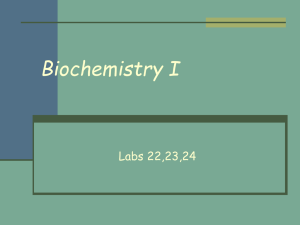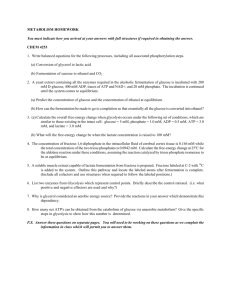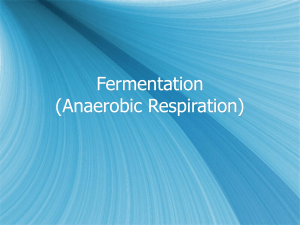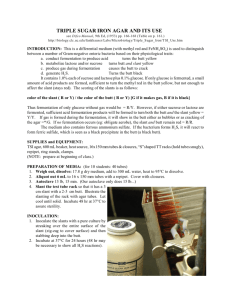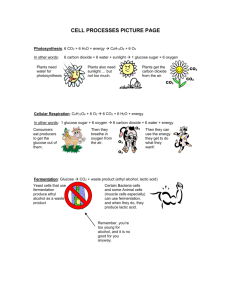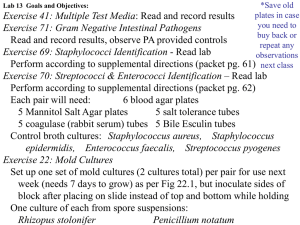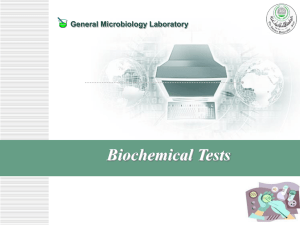TSI Agar Test: Protocol & Interpretation
advertisement
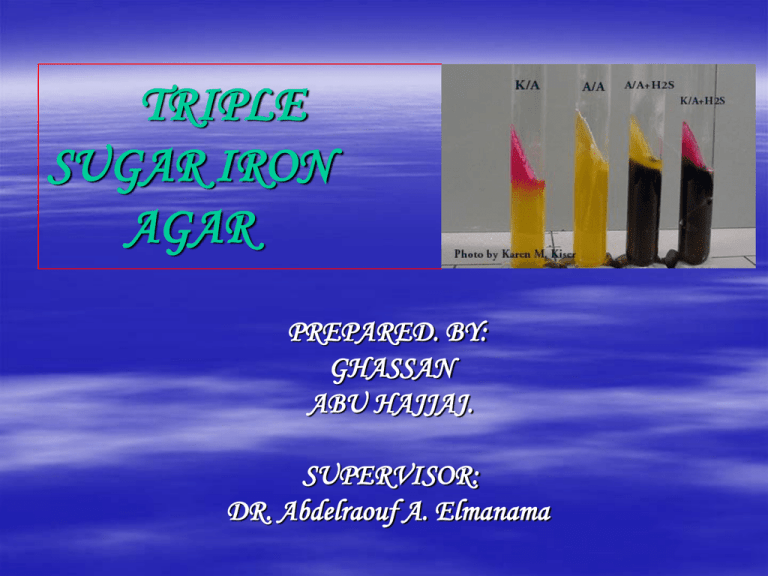
TRIPLE SUGAR IRON AGAR PREPARED. BY: GHASSAN ABU HAJJAJ. SUPERVISOR: DR. Abdelraouf A. Elmanama INTRODUCTION: Triple sugar iron agar (TSI) is a differential medium that contains lactose, sucrose, a small amount of glucose (dextrose), ferrous sulfate, and the pH indicator phenol red. It is used to differentiate enterics based on the ability to reduce sulfur and ferment carbohydrates. THE TEST: As with the phenol red fermentation broths, if an organism can ferment any of the three sugars present in the medium, the medium will turn yellow. If an organism can only ferment dextrose, the small amount of dextrose in the medium is used by the organism within the first ten hours of incubation.. After that time, the reaction that produced acid reverts in the aerobic areas of the slant, and the medium in those areas turns red, indicating alkaline conditions. The anaerobic areas of the slant, such as the butt, will not revert to an alkaline state, and they will remain yellow. This happens with Salmonella and Shigella. NOTE: SIM medium should be read after an incubation of only 24 hours because a longer incubation time can cause a false negative. Vigorous fermenters and Escherichia coli such as will ferment all the Entrobacter cloacae available sugars and then begin using the amino acids. This will produce amine groups and cause the medium to turn alkaline. If an organism can reduce sulfur, the hydrogen sulfide gas which is produced will react with the iron to form iron sulfide, which appears as a black precipitate. If the precipitate is formed, it can mask any acid/alkaline results. Sulfur reduction requires an acidic environment, so if the black precipitate is present, some fermentation took place. If the butt of the slant is obscured by the precipitate, look at the top of the slant to determine if the organism could ferment only dextrose (red), or if it could ferment either lactose and/or sucrose (yellow). If the fermentation produced gas, you may see fissures in the medium, or the entire slant may be raised above the bottom of the test tube. Enterobacter cloacae exhibits fermenation of glucose and gas production but no sulfur reduction This would be read K/A,G. Staphylococcus aureus exhibits acidic fermentation. This would be read A/A. Salmonella typhimurium ferments glucose and reduces sulfur. This would be read K/A, H2S. Micrococcus luteus uses the amino acids and does not grow in the butt of the slant. This would be read K/NC. Bacillus megaterium fermented sugars but did not grow in the anaerobic environment of the butt. This would be read A/NC. Enterobacter fermented the sugars but turned to the aerogenes amino acids. This would be read K/A. Results (slant/butt) Symbol Interpretation Red/yellow K/A Glucose fermentation only; Peptone catabolized Yellow/yellow A/A Glucose and lactose and/or sucrose fermentation Red/red K/K No fermentation; Peptone catabolized Red/no color change K/NC No fermentation; Peptone used aerobically Yellow/yellow with bubbles A/A,G Glucose and lactose and/or sucrose fermentation; Gas produced Red/yellow with bubbles K/A,G Glucose fermentation only; Gas produced K/A,G, H2S Glucose fermentation only; Gas produced; H2S produced Red/yellow with black precipitate K/A, H2S Glucose fermentation only; H2S produced Yellow/yellow with black precipitate A/A, H2S Glucose and lactose and/or sucrose fermentation; H2S produced Red/yellow with bubbles and black precipitate A=acid production; K=alkaline reaction; G=gas SOME COMMON SUGAR REACTIONS IN TSIA A/A K/A K/K A/K E. coli, Yersinia, Aeromonas, Vibrio Salmonella, Edwardsiella, Shigella nonfermenters such as Pseudomonas and others erroneously inoculated a Gram + or some other weird thing

